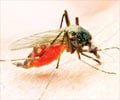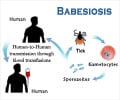Study identifies that P113 protein helps to form a molecular bridge between the parasite and red blood cell.

- The Plasmodium parasites need protein RH5 to bind to the surface of the human blood cells and invade it.
- But the mechanism using which RH5 attaches to the surface of the parasite was unknown.
- The research team have discovered a protein on the surface of the parasite called P113 that anchors the RH5 protein to it.
Malaria
Malaria is a life-threatening disease caused by Plasmodium parasites which are transmitted by infected female Anopheles mosquitoes. It is endemic to tropical and sub-tropical areas of Africa, South America and Asia.
More than 200 million people a year are infected with malaria.
In 2013, it is estimated that there were 198 million cases of malaria and 584,000 deaths.
Children under the age of five made up 70% of these deaths.
Role of P113
Previous research by teams at the Sanger Institute discovered that Plasmodium parasites need RH5 to bind to a receptor called basigin on the surface of the blood cells, to invade human red blood cells.
But the mechanism by how RH5 attached to the surface of the parasite.
In the recent study, the researchers discovered that when the Plasmodium RH5 protein is released, it is immediately caught by another parasite protein called P113.
There are thousands of P113 molecules on the surface of each parasite that act like a Velcro chain, anchoring RH5 at the surface of the parasite.
The tethered RH5 then binds to the basigin receptor on the human red blood cell, bridging the gap and allowing the to parasite invade the blood cell.
Dr Julian Rayner, an author on the study from the Sanger Institute, said "We knew both proteins were essential for invasion but this is the first time anyone has seen the interaction between RH5 and P113 and showed that they work together. In theory, an antibody that blocked P113 could stop RH5 binding and so prevent the parasite from gaining entry to red blood cells. This makes the P113 protein another good vaccine target."
Dr Francis Galway, first author on the study from the Sanger Institute, added "RH5 is an excellent vaccine target because it is essential for invasion by all strains of Plasmodium falciparum - the species of parasite that causes the most severe disease in humans. This study shows us the binding partners for the RH5 protein and how these work together to allow the parasite to enter red blood cells. This gives us important information about this vaccine target."
Dr Gavin Wright, lead author from the Sanger Institute, said "There is a great need for an effective malaria vaccine, and the RH5 complex is the most important link between parasite and host that we yet know of. This study shows us how this works, and reveals other essential malarial proteins to target. As RH5 is only exposed from the parasite briefly, a combination vaccine based on P113, RH5 and other proteins in the complex could be more effective than RH5 alone."
The study is published in Nature Communications.
Reference
- Francis Galway et al. Nature Communications; (2017)
Source-Medindia














